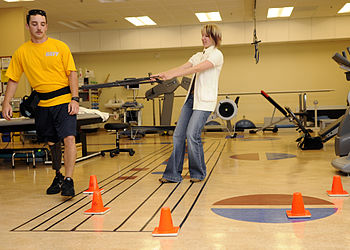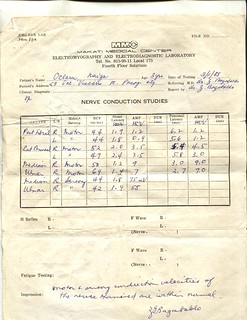 |
| hiring (Photo credit: groundswell) |
The right talent in today's complex knowledge-based job market has never been more critical to an organization's bottom line — or more difficult to obtain. Medical businesses are seeking better ways to secure a higher level of productivity, performance and profitability from their investment in human capital. However, many of them haven’t calculated the total costs of employee turnover, a major cause of which is hiring the wrong talent for the job from the get-go.
After working in the medical field for a combined 25 years, noticing the difficulty of finding, matching, developing and maintaining good staff over the long term, we decided to develop a tool that goes far beyond what you’ll find on the standard job boards. We wanted a comprehensive method that would enable employers to objectively identify and match key behavioral profiles, manage the recruitment/interview/decision-making process, and ultimately help them retain high-quality employees, thus saving the expenses associated with the hiring and training process.
 |
| Standardized Test (Photo credit: biologycorner) |
To that end, MedMasters is now offering a complimentary online assessment for companies to compare its top-producing employees with potential job candidates. It's available to all employers who sign up with a new, one-year membership. Companies can use this assessment to compile a baseline study of its top performers in regards to their behavioural and motivational styles. This gives employers an objective way to assess and benchmark its top performers based on their behavioral and motivational skill sets. The companies can then use the assessment results to evaluate and compare its top employees with candidates they’re currently considering for job openings. The closer job candidates match the companies’ best performers on these assessments, the more likely they’ll succeed at the job. The one page-study includes easy-to-understand graphs based on the study results.
Companies simply choose its top echelon sales performers and have them take the15-minute assessment. This data is combined to produce a summary that tells employers exactly what type of candidate they’re looking for, based on the results given to them by their top echelon people.
Advantages of Benchmarking
 |
| Simple Graph (Photo credit: Wikipedia) |
Consider this common scenario: Oftentimes there may be two or more highly qualified candidates. And occassionally, the candidate who is hired was chosen on someone’s gut instinct or even by corporate nepotism. Performing a benchmark study of the top performers and measuring potential candidates against those results can provide a more accurate and objective way to assure, with a higher degree of accuracy, the right candidate is offered the job. Assessment and benchmark testing are inherently more accurate and objective, thus assuring the absolute right candidate(s) are offered the job.
Another use of the study is to benchmark the bottom half of their sales performers in order to see how they differ from their all-stars.
These key tools offered by MedMasters provide additional ways assess and retain talent as well as
effectively diminish turnover by consistently helping identify the candidate who is the best fit for a particular job. Great fits are highly correlated with low turnover — followed along with a sound management and development plan customized for each new hire, which also reduces turnover.
 |
| At work in TheHiveAshdod (Photo credit: GVAHIM) |
MedMasters also offers various other assessment tools that measure sales skills, sales talent comparisons, sales DNA, leadership capabilities and coaching reports. The coaching reports are very effective because they provide managers with the ability to better communicate expectation in a language employees can understand.
MedMasters’ assessments and methodologies are based on 40 years of data and research, where employers can proactively optimize their investment in their employees. These human resources solutions are proven, measurable, and provide optimal results.
Individual Members Benefit, Too
MedMasters also makes the assessment available to all of our professional members to complete at no charge to take it and then post their results on their MedMasters’ profile page. Employers can then source candidates based not only the skill sets and experience of the candidates, but also on how their assessment profile matches up with the results of its top performers. The closer the match, the more likely a new hire will succeed at the job. at the level of the company’s top performers. And incidentally, when employers locate a MedMasters member that has the background they're looking for, but hasn’t yet completed and posted an assessment, they can simply send that potential candidate a MedMail request to complete it.
It’s Getting Better All the Time
 In addition to providing its new one-year employer members with the assessment, MedMasters will also provide them a free copy of Dr. Charles Coker’s newest book, “Profit Through Your People: How the Human Factor Can Impact Your Bottom Line.” The book, written by the nationally published, multi-award-winning Coker, is currently available at Amazon.
In addition to providing its new one-year employer members with the assessment, MedMasters will also provide them a free copy of Dr. Charles Coker’s newest book, “Profit Through Your People: How the Human Factor Can Impact Your Bottom Line.” The book, written by the nationally published, multi-award-winning Coker, is currently available at Amazon.For those who didn’t catch our previous blog in March, “You Must Assess to Recruit & Retain the Best,” Dr. Charles “Chuck” Coker, SPHR, PhD, who wrote that article, serves as MedMasters’ Vice President of Human Capital Strategies. He holds professional designations as a Certified Professional Behavioral Analyst, Certified Professional Values Analyst and is Certified in the Myers-Briggs Type Indicator. Harvard University, Florida State University and Westminster Theological Centre (in the UK) have hired Dr. Coker and/or used his methodology for the basis of specific courses and academic studies.
Having Dr. Coker on MedMasters’ executive team assures we’re providing cutting-edge, proven research on assessment and behavioral testing. Such organizations as Harvard Medical School, Mayo Clinic, Medco, AT&T, General Foods, Harris Corporation, Sprint PCS and MecLabs Group have all retained his expertise to guide them through the recruitment, acquisition and retention of high-value employees.
Especially with our detailed assessment testing, and our new Groups platform in our social media side, MedMasters provides professional members and recruiters/employers with a broad set of applicable tools that are unique to the health care industry.
In our ongoing quest to provide be the best job board and social networking site available to the health care industry, MedMasters will continue to incorporate added value for hiring companies, recruiters and medical professionals who join the site.
If you found this article useful, please leave a comment below and also feel free to share and repost it.
Rick Fromme combines entrepreneurial enthusiasm with an insider's knowledge of the medical industry to co-found MedMasters.com. Both his drive and perspective helps provide health care professionals with a superior mechanism with which to communicate, network and market their strengths. Prior to founding MedMasters.com, Rick operated a highly successful medical device distributorship. Other milestones in his 12-year career in the medical industry include a key position at a medical device start-up company that was later sold to the Ethicon Endo division of Johnson & Johnson. You may reach Rick by connecting with him on Facebook, Twitter, Google+, LinkedIn and YouTube.
Related Articles





















































